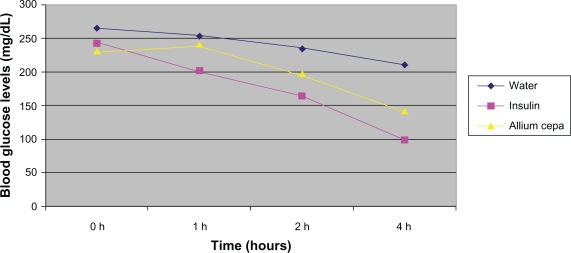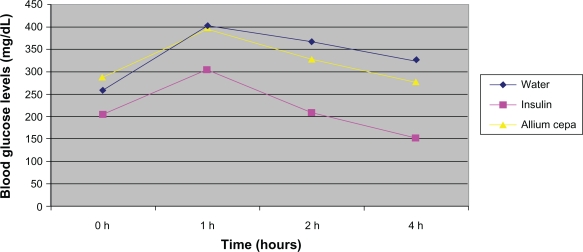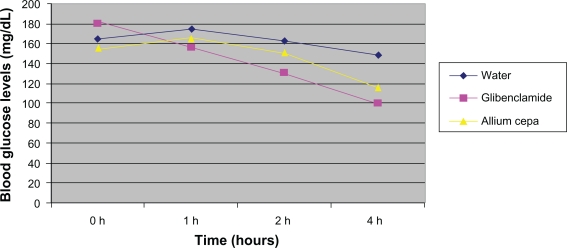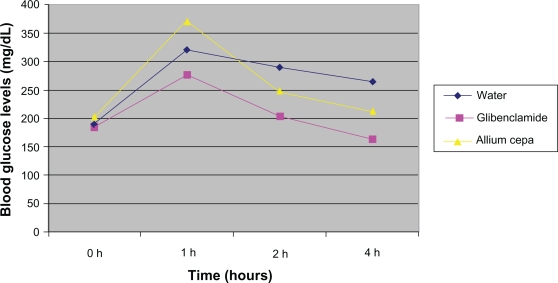Abstract
Background:
Diabetes mellitus is a heterogeneous group of disorders characterized by abnormalities of carbohydrate, protein and lipid metabolism. Type 1 diabetes mellitus is an autoimmune disease caused by destruction of pancreatic beta cells and characterized by defect in insulin secretion while type 2 diabetes mellitus results from abnormalities in insulin secretion and/or insulin action or both.
Objectives:
The present study was conducted to investigate the clinical hypoglycemic effects of Allium cepa in type 1 and type 2 diabetic patients.
Results:
In assessment of hypoglycaemic activity of Allium cepa in type 1 and type 2 diabetic patients, ingestion of crude Allium cepa (100 g) caused a considerable reduction in fasting blood glucose levels by about 89 mg/dl in relation to insulin (145 mg/dl) in type 1 diabetic patients and it reduced fasting blood glucose levels by 40 mg/dl, compared to glibenclamide (81 mg/dl) in type 2 diabetic patients, 4 hours later. The same dose of crude Allium cepa produced a significant reduction in the induced hyperglycemia (GTT) by about 120 mg/dl compared to water (77 mg/dl) and insulin (153 mg/dl) in type 1 diabetic patients and considerably reduced GTT by 159 mg/dl in relation to water (55 mg/dl) and glibenclamide (114 mg/dl) in type 2 diabetic patients, after 4 hours.
Conclusion:
It was evident that, crude Allium cepa produced hypoglycemic effects, thus it could be used as a dietary supplement in management of type 1 and/or type 2 diabetes mellitus.
Keywords: Allium cepa, hypoglycemia, type 1 and type 2 diabetes mellitus, diabetic patients
Introduction
In the year 2000, according to the World Health Organization, at least 170 million people worldwide (2.8% of the population) suffer from diabetes. Its incidence is increasing rapidly, and it is estimated that by the year 2030, this number will almost double. Based on its etiology, diabetes mellitus is generally divided into three classifications: type 1, type 2 and gestational.1 Type 1 is an autoimmune disease characterized by a defect in insulin secretion such that the pancreas produces little or no insulin. It occurs most often in children and young adults and accounts for 5%–10% of cases of diabetes. Type 2 diabetes is a metabolic disorder characterized by a defect in insulin secretion and/or tissues are resistant to its uptake. Type 2 accounts for 90%–95% of cases of diabetes.1,2 The chronic hyperglycemia that characterizes diabetes mellitus results from either defects in insulin secretion or insulin action and/or both. When left unchecked, hyperglycemia precipitates micro and/or macrovascular complications including: cardiovascular disease, nephropathy, neuropathy, and retinopathy. Insulin and oral hypoglycemic agents are used in the management of type 1 and type 2 diabetes mellitus respectively.1,2
Medicinal plants continue to provide valuable therapeutic agents, in both modern medicine and traditional systems.3 Over four hundred traditional plant treatments for diabetes have been reported, although a small number of these have received scientific and medical evaluation to assess their efficacy and safety.4,5 Of these, ginseng species, Momordica Charantia (Bitter Melon), cloves, cinnamon, Trigonella foenum graecum (Fenugreek) and Allium cepa (onion) have been used for taste and flavour development in food preparations.5,6
The use of plants especially vegetables by the population as antidiabetic remedies have added interest of joining two basic diabetes mellitus control factors: food and medication.5–8 Allium species such as onion has attracted particular attention of modern medicine because of its widespread health use around the world, and the cherished belief that it helps in maintaining good health, warding off illnesses and providing vigor.4 Onion is rich in flavonoids such as quercetin and sulphur compounds, such as cysteine and allyl propyl disulphide that have perceived benefits to human health. These compounds possess antidiabetic, antibiotic, hypocholesterolaemic, fibrinolytic, and other various beneficial biological effects.9,10 The present study was conducted to investigate the clinical hypoglycemic effects of Allium cepa in type 1 and type 2 diabetic patients.
Materials and Methods
Plant material
Fresh and recently cropped Allium cepa harvested at the optimal maturity was purchased from the local market in Wad Medani city, Central Sudan. The fresh onion was cut into small slices to be taken orally by type 1 and type 2 diabetic patients.
Criteria for selecting patients
For patients with type 1 and/or type 2 diabetes mellitus, the following criteria of selection were considered: age ≤50 years (mean 44 ± 3.87), the duration of diabetes was between 2–5 years, not taking medicines for other health condition, not taking vitamins or other supplements, not smoking or consuming alcohol and not suffering from any of diabetes complications.
Determination of fasting blood glucose levels and glucose tolerance tests in type 1 and type 2 diabetic patients
Two groups of type 1 and two groups of type 2 diabetic patients of both sexes were used in these clinical trials to assess the hypoglycaemic effects of Allium cepa. For the two groups (I, II) of type 1 diabetic patients, the participants of group I (n = 21) and group II (n = 21) were subjected to fasting blood glucose levels determination and glucose tolerance tests respectively. The two groups were subdivided into six subgroups (Ia, Ib, Ic and IIa, IIb, IIc) each consisted of seven registered patients (2 females and 5 males). Participants of the subgroups Ia, Ib and Ic were used for determination of fasting blood glucose levels while those of IIa, IIb and IIc were subjected to glucose tolerance tests after induction of hyperglycemia by administration of 75 g dextrose orally. The participants of subgroups Ia and IIa received water (negative control), while those of subgroup Ib and IIb (positive control) were administered standard treatment of insulin (5 IU/prescribed doses and glibenclamide 5 mg/kg) respectively and those comprising subgroup Ic and IIc received 100 g of the crude fresh slices of Allium cepa as test groups (equivalent to 20 g dry drug).11 The participants received the tested materials in the morning at 8 am. Fasting blood glucose levels and glucose tolerance tests were determined at 0, 1, 2 and 4 hours using an electronic glucometer (Tables 1 and 2; Figs. 1 and 2).
Table 1.
Fasting blood glucose levels in type 1 diabetic patients receiving water (5 ml), insulin (5 IU/prescribed dose) and Allium cepa (100 g).
| Preparations |
Blood glucose level (mg/dL, mean ± S.E.M) Normal range 80–120 mg/dl13 |
Pvalue | |||
|---|---|---|---|---|---|
| 0 h | 1 h | 2 h | 4 h | ||
| Water | 266 ± 7.22 | 254.33 ± 7.68 | 236 ± 8.39 | 211 ± 11.85 | 0.03 |
| Insulin | 243 ± 8.08 | 204 ± 8.72 | 165 ± 4.583 | 98.67 ± 2.90 | 0.001 |
| Allium cepa | 232 ± 7.72 | 241 ± 10.045 | 198.25 ± 14.64 | 143.38 ± 14.182 | 0.005 |
Table 2.
Glucose tolerance tests in type 1 diabetic patients receiving water (5 ml), insulin (prescribed doses) and Allium cepa (100 g).
| Preparations |
Blood glucose level (mg/dL, mean ± S.E.M) Normal range 80–120 mg/dl13 |
Pvalue | |||
|---|---|---|---|---|---|
| 0 h | 1 h | 2 h | 4 h | ||
| Water | 259 ± 17.12 | 405 ± 16.34 | 368.5 ± 15.11 | 328 ± 14.33 | 0.03 |
| Insulin | 205 ± 21.37 | 304.33 ± 16.19 | 208 ± 24.269 | 152.67 ± 15.69 | 0.001 |
| Allium cepa | 291 ± 14.48 | 398.8 ± 14.23 | 328.6 ± 13.47 | 278.2 ± 16.04 | 0.004 |
Figure 1.
Fasting blood glucose levels in type 1 diabetic patients receiving water (5 ml), insulin (5 IU/prescribed dose) and Allium cepa (100 g).
Figure 2.
Glucose tolerance test curves in type 1 diabetic patients receiving water (5 ml), insulin (prescribed doses) and Allium cepa (100 g).
The other two groups (III, IV) of type 2 diabetic patients were tested to evaluate the hypoglycemic effects of Allium cepa. The participants of group III (n = 21) and group IV (n = 21) were subjected to fasting blood glucose levels determination and glucose tolerance tests respectively. The two groups were subdivided into six subgroups (IIIa, IIIb, IIIc and IVa, IVb, IVc) each consisted of seven registered patients. Participants of the subgroup IIIa, IIIb and IIIc were used for determination of fasting blood glucose levels while those of IVa, IVb and IVc were subjected to glucose tolerance tests after induction of hyperglycemia by administration of 75 g dextrose orally. The participants of subgroup IIIa and IVa received water (negative control), subgroup IIIb and IVb were considered as positive control groups and administered standard treatment of glibenclamide (5 mg/day) and those comprising subgroup IIIc and IVc were received 100 g of the crude fresh slices of Allium cepa as investigational (test) groups. Fasting blood glucose levels and glucose tolerance tests were determined at 0, 1, 2 and 4 hours (Tables 3 and 4; Figs. 3 and 4).
Table 3.
Fasting blood glucose levels in type 2 diabetic patients receiving water (5 ml), glibenclamide (5 mg) and Allium cepa (100 g).
| Preparations |
Blood glucose level (mg/dL, mean ± S.E.M) Normal range 80–120 mg/dl13 |
Pvalue | |||
|---|---|---|---|---|---|
| 0 h | 1 h | 2 h | 4 h | ||
| Water | 164.33 ± 18.5 | 175 ± 22.26 | 162.33 ± 19.1 | 148.67 ± 8.67 | 0.001 |
| Glibenclamide | 181 ± 11.71 | 157.5 ± 11.25 | 131 ± 7.5 | 100.38 ± 6.41 | 0.003 |
| Allium cepa | 155 ± 25.29 | 165 ± 26.41 | 150.25 ± 17.73 | 115.5 ± 15.46 | 0.005 |
Table 4.
Glucose tolerance test (GTT) in type 2 diabetic patients receiving water (5 ml), glibenclamide (5 mg) and Allium cepa (100 g).
| Preparations |
Glucose level (mg/dL, mean ± S.E.M) Normal range 80–120 mg/dl13 |
Pvalue | |||
|---|---|---|---|---|---|
| 0 h | 1 h | 2 h | 4 h | ||
| Water | 190 ± 18.55 | 320 ± 22.26 | 290 ± 19.1 | 265 ± 8.67 | 0.004 |
| Glibenclamide | 185.6 ± 25.29 | 277 ± 26.41 | 203.8 ± 17.73 | 163.2 ± 15.46 | 0.001 |
| Allium cepa | 204.63 ± 11.7 | 372.5 ± 11.25 | 249 ± 13.2 | 213 ± 14.11 | 0.002 |
Figure 3.
Fasting blood glucose levels in type 2 diabetic patients receiving water (5 ml), glibenclamide (5 mg) and Allium cepa (100 g).
Figure 4.
Glucose tolerance test curves in type 2 diabetic patients receiving water (5 ml), glibenclamide (5 mg) and Allium cepa (100 g).
Ethical approval
The ethical approval for this study was obtained from the Ethical Committee/University of Gezira/Gezira State, Ministry of Health, Wad Medani-Sudan. Consent forms were signed by participants, being interested in joining the study completely voluntary.
Statistical analysis
All the data were expressed as means ± standard error of means (SEM) and analyzed by analysis of variance (ANOVA). Comparisons with the control groups were made using One-way ANOVA. Differences were considered significant if P < 0.05.
Results and Discussion
Determination of fasting blood glucose levels and glucose tolerance tests in type 1 diabetic patients
Results obtained are shown in Table 1; Figure 1. For group 1 diabetic patients with type 1 diabetes mellitus, the fasting blood glucose levels in the tested patients ranged between 232 and 266 mg/dl. The blood glucose values in the negative control subgroup Ia did not show much variations and the slight reduction in the blood glucose levels could be attributed to fasting. After the administration of insulin (5 IU/prescribed dose) a significant reduction in the fasting blood glucose levels in subgroup Ib (positive control) by 145 mg/dl was observed 4 hours later. While the administration of Allium cepa (100 g) caused a considerably lowered value in the fasting blood glucose levels in subgroup Ic of diabetic patients (test group) by about 89 mg/dl after 4 hours compared to reduction caused by water and insulin. Such effect was also evidently noted in a previous clinical study where the juice of Allium cepa was administered orally to diabetic patients despite the low dose (50 mg) taken by them.12
For group II of type 1 diabetic patients (subgroup IIa, IIb, and IIc) blood glucose levels were determined at 0, 1, 2, and 4 hours using electronic glucometer. Results obtained showed that the administration of 75 g dextrose caused high increase in the blood glucose levels in the three subgroups after the first hour represented by hyperglycaemic peak (Fig. 2). It has been also observed that the administration of Allium cepa produced a significant (P = 0.004) reduction in the induced hyperglycemia by about 120 mg/dl in relation to water (77 mg/dl) and the standard drug insulin (152 mg/dl) four hours later. While for the same period of time the effect of the oral administration of Allium cepa demonstrated a relatively slight and gradual decrease in fasting blood glucose levels compared to insulin (Table 2 and Fig. 2) and as shown in a similar clinical study performed by Shukia et al, (2000) who described such a decrease in glucose-induced hyperglycemia in human adults.14
Determination of fasting blood glucose levels and glucose tolerance tests in type 2 diabetic patients
For group III of type 2 diabetic patients and as shown in Table 3 and Figure 3 fasting blood glucose levels were determined. The administration of 100 g of crude Allium cepa markedly reduced the fasting blood glucose levels in subgroup IIIc diabetic patients (test group) by 40 mg/dl after 4 hours (P = 0.005).
The oral administration of glibenclamide (5 mg/day) produced a significant reduction in fasting blood glucose levels in subgroup IIIb diabetic patients by about 81 mg/dl, four hours later. As glibenclamide acts by direct induction of insulin release from the pancreatic beta cells, such a significant reduction in glucose levels was virtually evident.15
The hypoglycemic activity of Allium cepa has been demonstrated in many clinical studies, presenting that, the addition of raw onion to the diet for non-in-sulin-dependent diabetic subjects decreased the dose of antidiabetic medication required to control the disease.16 Moreover, it was worthy noted that oral administration of Allium cepa crude hydroalcoholic extract in animal models (alloxan-induced diabetic rats) produced a significant hypoglycemic activity and favourable good health effects which may be most probably attributed to improvement and/or regeneration of pancreatic beta-cells.17 Allium cepa acts as a hypoglycemic agent by mechanisms rather than increasing insulin levels having extra pancreatic effects; acting directly on tissues as liver, muscles etc. and alter the activities of the regulatory enzymes of glycolysis, gluconeogenesis and other pathways.14,16,18
In group IV of type 2 diabetic individuals it was noticed that, the administration of 75 g dextrose caused an increase in the blood glucose levels in all subjects after one hour demonstrated by hyperglycemic peak (Fig. 4). Among the three subgroups, those who had received Allium cepa showed the highest peak. Nevertheless, after this substantial increase in glucose levels onion administration significantly reduced the blood glucose levels to a point below that produced in the negative control group after 4 hours (Table 4; Fig. 4). The oral administration of glibenclamide (5 mg) showed a significant reduction in the induced hyperglycemia in the participants of the positive control subgroup by 157 mg/dl after 4 hours, compared to water, since it is known to act by direct induction of insulin release from the pancreatic beta cells.16
The observed increase in fasting blood glucose levels in all subgroups during the first hour and after ingestion of Allium cepa (Tables 1 and 3) which attributed to its glucogenic effects of Allium cepa20,21 can counteract the common side effect (hypoglycemia) of antidiabetic agents currently used if Allium cepa is taken concurrently as food supplement and as presented in previous studies cysteine present in Allium cepa could be the main cause of the glucogenic effects of onion.19,21
Although the number of participants in the study groups is small to reach concrete conclusions, Allium cepa in addition to its nutritional values has hypoglycemic effects that could be beneficial in management of type 1 and type 2 diabetic patients of all age groups, especially the level of its safety as reflected by its worldwide use as vegetable.
Footnotes
Disclosure
This manuscript has been read and approved by all authors. This paper is unique and is not under consideration by any other publication and has not been published elsewhere. The authors and peer reviewers of this paper report no conflicts of interest. The authors confirm that they have permission to reproduce any copyrighted material.
References
- 1.American Diabetes Association Reports of the Experts Committee on the Diagnosis and Classification of Diabetes Mellitus. Diabetes Care. 2001;23:S4–19. [PubMed] [Google Scholar]
- 2.American Diabetes Association Hyperglycemic crises in patients with diabetes mellitus. Diabetic Care. 2001;24:S83–90. doi: 10.2337/diacare.24.1.154. [DOI] [PubMed] [Google Scholar]
- 3.Reaven E, Wright D, Mondon CE, Solomon HO, Reaven GM. Effect of age and diet on insulin secretion and insulin action in rat. Diabetes. 1983;32:175–80. doi: 10.2337/diab.32.2.175. [DOI] [PubMed] [Google Scholar]
- 4.Jain RC, Vyas CR. Effects of onion and garlic in atherosclerotic heart disease. Medikon. 1977;6:12–4. [Google Scholar]
- 5.Nazar S. Hypoglycemic Activity of Nineteen Sudanese Medicinal Plants with Emphasis on: Allium cepa L. (Red onion) 2006. Thesis for M. Pharm, Faculty of Pharmacy, University of Gezira, Sudan;
- 6.Khan A, Mahpara S, Mohamed M. Cinnamon Improves Glucose and Lipids of People With Type 2 diabetes. Diabetes Care. 2003;26:3215–8. doi: 10.2337/diacare.26.12.3215. [DOI] [PubMed] [Google Scholar]
- 7.Bordia M, Verma SK. Effects of garlic feeding on regression of experimental atherosclerosis in rabbits. Artery. 1980;7:428–37. [PubMed] [Google Scholar]
- 8.Ali M, Thomson B. Consumption of garlic and clove a day could be beneficial in of prevention thrombosis. Prostaglandins Leukotrienes and Essential Fatty Acids. 1995;53(3):211–2. doi: 10.1016/0952-3278(95)90118-3. [DOI] [PubMed] [Google Scholar]
- 9.Dorant E, van den B, Dorant PA, Goldbohm RA. Allium vegetable consumption, garlic supplement intake, and female breast carcinoma incidence. Breast Cancer Res Treatment. 1995;33:163–70. doi: 10.1007/BF00682723. [DOI] [PubMed] [Google Scholar]
- 10.Banerjee SK, Maulik SK. Effects of garlic on cardiovascular disorders: a review. Nutritional Journal. 2002;1(4):1–14. doi: 10.1186/1475-2891-1-4. [DOI] [PMC free article] [PubMed] [Google Scholar]
- 11.WHO . Monograph on selected medicinal plant, Allium cepa. Vol. 1. Geneva: 1999. [Google Scholar]
- 12.Griffiths G, Trueman L, Crowther T, Thomas B. Onions: a global benefit to health. Phytotherapy Research. 2002;17(7):603–15. doi: 10.1002/ptr.1222. [DOI] [PubMed] [Google Scholar]
- 13.Trinder P. Ann. Determination of clinical glucose, serum cholesterol and insulin levels. Clinical Biochemistry. 1989;6:24–8. [Google Scholar]
- 14.Shukia R, Sharma SB, Puri D, Prabhu KM, Murthy PS. Medicinal plants for treatment of diabetes mellitus. Indian Journal of Clinical Biochemistry Sciences. 2000;15B-164(14):201–30. doi: 10.1007/BF02867556. [DOI] [PMC free article] [PubMed] [Google Scholar]
- 15.Katzung G. Bertran. Basic and clinical pharmacology. Pancreatic hormones and antidiabetic drugs. 8th ed. Vol. 41. The McGraw-Hill; New Yourk: 2001. pp. 711–334. [Google Scholar]
- 16.Bhushan S. Effect of oral administration of raw onion on glucose tolerance test of diabetics: a comparison with tolbutamide. Current Medical Practice. 1984;28:712–5. [Google Scholar]
- 17.Taj Eldin Imad M, Ahmed Elhadi M, Elwahab HM Abd. Hypoglycemic Activity and Regeneration of Pancreatic Beta-cells Produced by Allium cepa in Alloxan-induced Diabetic Rats. Omdurman Journal of Pharmaceutical. 2009;1(5):562–8. [Google Scholar]
- 18.Taj Eldin Imad M, Ahmed Elhadi M, Elwahab HM Abd. Clinical Hypoglycemic and Hypocholesterolemic Effects of Allium cepa in Normal Human Volunteers. The National Centre for Research; Khartoum: 2008. Accepted for publication in Albuhuth Scientific Journal. [Google Scholar]
- 19.Schepartz B. Regulation of Amino Acid Metabolism in Mammals. Clinical Chemistry. 1973;20(3):405–6. [Google Scholar]
- 20.Augusti KT. Therapeutic values of onion (Allium cepa L.) and garlic (Allium sativum L.) Indian Journal of Experimental Biology. 1996;34:634–40. [PubMed] [Google Scholar]
- 21.Taj Eldin Imad M, Ahmed Elhadi M. The hypoglycemic effects of cysteine in normal rabbits (unpublished work). 2008.






